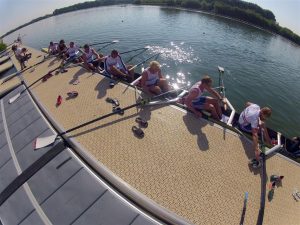The summer games have all the elements of a great story—power, drama, intrigue, and the key moment when one team rises above the rest and is dressed in gold. I guess I can’t help but love the games -- and as a professional communicator, I can’t resist a great story.
Increasingly, narratives of perfect sports moments will include a new character: big data. Just as statistics changed baseball—as outlined in Michael Lewis’s best-selling book, Moneyball, and the 2011 film starring Brad Pitt—data is changing the way athletes train, and the way they approach competitions.
SAS is part of that story. SAS is the official analytics partner for British Rowing and the GB Rowing team. Over in the UK, our folks are helping the British rowing team apply data analytics to their rigorous training. They are hoping it pays off with a trip to the podium. In this video, my colleague across the pond Hugo D’Ulisse explains it well:
“As performance gains get smaller and smaller, as the margin of victory gets smaller and smaller, how can you use data from the past to inform decisions that you make today?”
In a sport like rowing, which has multiple variables—data can help make the difference between two highly talented, hardworking teams. While a runner works independently, rowing includes multiple athletes working together, in a boat, on an extremely unpredictable surface—water. Data about each of these elements—from SAS—is helping create a fuller, more intelligent picture of victory for Great Britain’s rowing team. As D’Ulisse puts it “It’s a complicated picture, and what we’re helping British rowing understand, is all three of those dimensions.”

At SAS, our products help our customer’s find and use information (gleaned from data) that will help them improve their business. Yes, sometimes it’s about improving profit margins, but it’s also about helping organizations bring humanitarian relief. In this case, it’s about helping a group of athletes perform at their best, earning them a chance at a gold medal. In all of these examples, SAS helps people bring about new, unanticipated possibilities.
Nowadays, it seems like everyone is talking about data. But unless you can show the power of data in a good story, it’s just a bunch of numbers. That’s why I’m certain that no matter how advanced our technology gets, we’ll always need great communicators.
If you watched the video I mentioned above, I’m sure you know what I mean. Reading that UK’s rowing team has partnered with SAS is one thing, it’s quite another to watch members of the team talk about all the elements of their performance that are measured and analyzed, and to hear them explain how the data has changed their sport.
Over the years, I’ve gotten used to telling stories about data and analytics. As the senior director of internal communications at SAS, it’s my job to share SAS’ success stories with our 14,000 employees working all around the world.
If the UK is triumphant, I’m sure we’ll hear more about the power of data. And I’m sure many more teams all over the world will be using SAS in the 2018 games—in South Korea—come around.
I can’t wait to see how Great Britain’s rowing team performs now that they’ve got the power of SAS analytics behind them. Even though my heart will always be with team USA, this summer, I won’t be able to stop myself from cheering for the UK (at least when it comes to rowing).
Related Content:
Training for the games: the countdown begins (guest post by world champion Paul Bennett of the GB Rowing Team)
Rowing: What has 150 years of data taught us?
What do an elite rower and a leading data scientist have in common?

1 Comment
Great story and video!